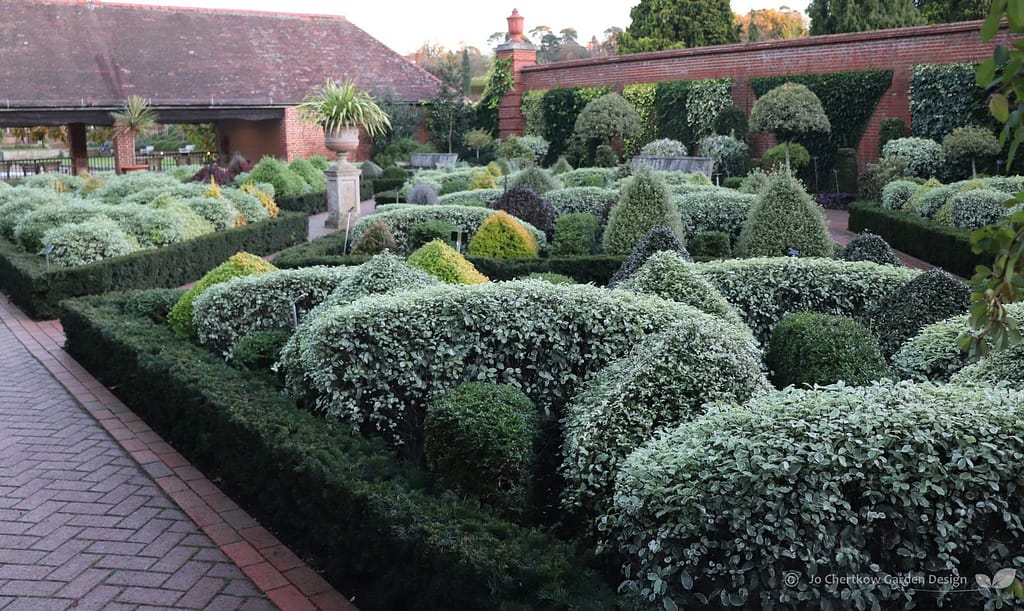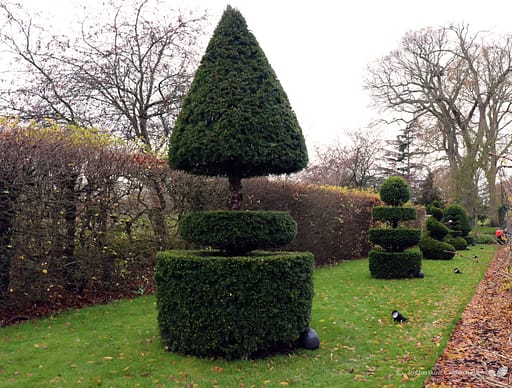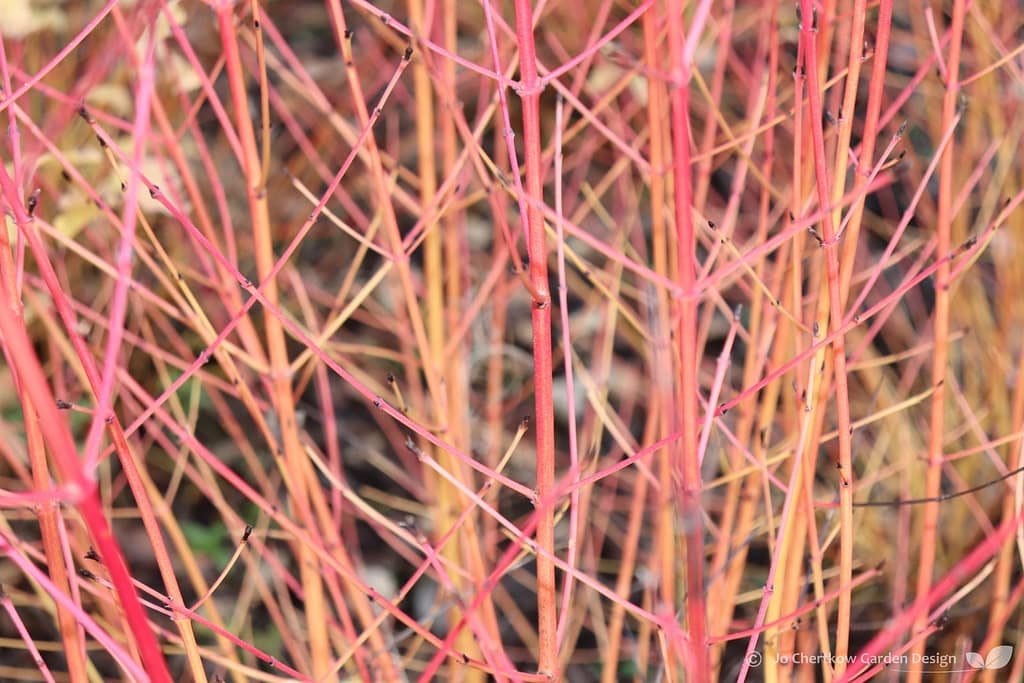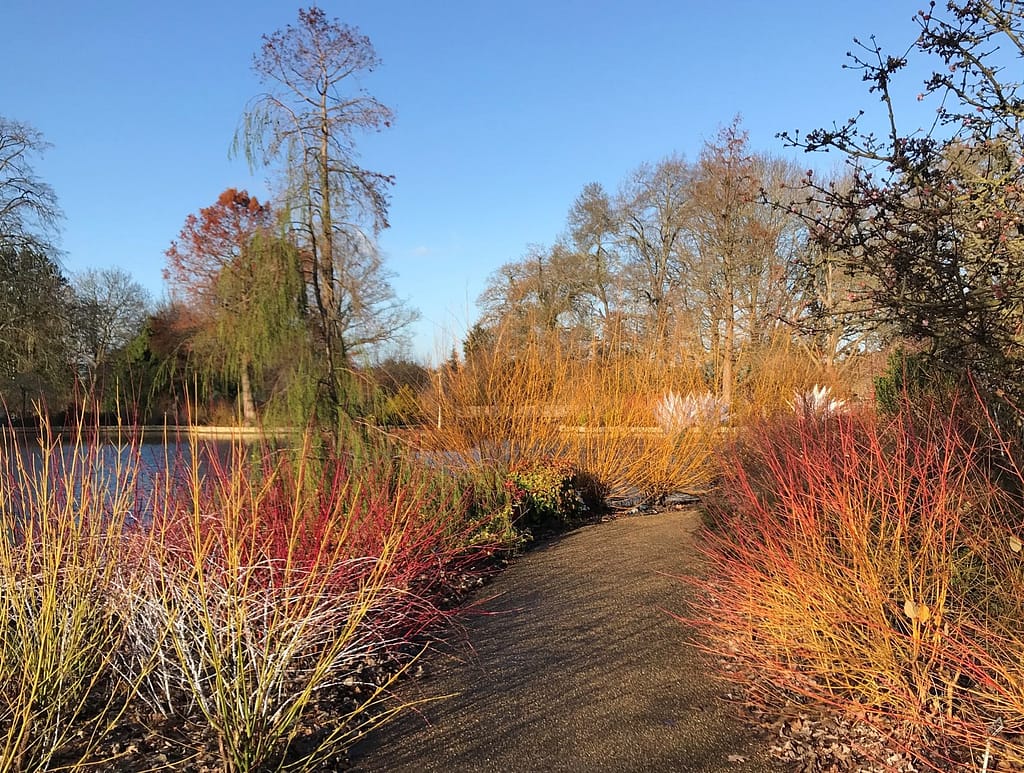It is easy to think that gardens are just for summer in our often damp gloomy climate. But a visit to any of the many public gardens that offer ‘Winter walks’ can provide rich inspiration to make your garden a year round destination. From colourful stems to evergreen structure and some truly intoxicating scents there are lots of options. I’ve chosen some key plants to make your garden a pleasure to experience through the darkest days of the year.
Planning for year round interest is also beneficial for wildlife. Winter flowering shrubs also offer a haven to over-wintering pollinators at the same time as offering us pleasure.
As many of us are spending more time at home due to Covid restrictions, making your garden a joy to spend time in in winter as well as summer can give your mood a real lift, especially if you are currently working from home. Strategic placement of key plants can brighten the prospect from your window or make a trip to the bins a pleasure!
Read on for my favourite plants to make your garden a joy to behold this winter.
Evergreens


One of the simplest ways of providing interest in our gardens over the winter months is through the use of evergreen structure. The classic English garden interpretation being the use of topiary yew (taxus baccata) and box (buxus sempivirens) to provide the essential bones of a garden is timeless. Frost sprinkled topiary can give a garden a stunning structure. But with box increasingly under threat, especially in London and the South East as the box moth caterpillar spreads, it is worth considering some alternatives.
Ilex crenata is a small leaved evergreen which looks very similar to box when clipped and is as a result very popular. Another option is one of the large range of varieties of small leaved Pittosporums from Pittosporum tenuifolium ‘Golf Ball’ which naturally forms a neat mound shape to silver and golden leaved varieties such as Pittosporum tenuifolium ‘Silver Queen’. See my blog on alternative evergreens to replace box for more information.

Introducing interest may not require planting new evergreens, but in fact new pruning techniques. Cloud pruning existing trees and shrubs can instantly transform a plant into a stunning specimen. Select the key stems to give your shrub or small tree structure and prune accordingly.
Stems


Stems and bark can also brighten a garden through the darkest months. Winter stars such as Cornus sanguinea ‘Midwinter Fire’ and Salix alba ‘Golden Ness’ can bring vibrant colour to the gloomiest winter scene. The best stem colours come from the new growth of various Cornus, Salix (Willow) and Acers.
If you have the enough space in your garden combining shrubs and trees with contrasting winter stems can provide a stunning display.

Key to the repeated display of the stunning colours these plants produce is the pruning. These are not plants to just put in your garden and forget. For the best colour all growth should be pruned out in spring (once the plant is established), either to the ground to keep the plant low or pollard it as desired. Feed the plants after pruning with with a general purpose fertiliser to give them the energy they need to put on vibrant new growth and they will reward you the following winter. For information on how to maintain these fabulous shrubs and the rest of your garden consider contacting me about a bespoke garden maintenance plan for your garden or click here for more information.
Trees can also add interest to the garden at this time of year through decorative bark. Silver birch varieties such as Betulus utilis ‘Jaquemontii’ are rightly popular trees with stunning white bark when mature, but there are plenty of other trees with attractive bark.

Consider the less common birch Betulus albosinensis with its burnished pinky bark or for richer colour Prunus serrula.

Flowers and scent
With pollinators less active in the winter months flowers that bloom now often have the most intense scents to capture their attention. When including these in your garden be sure to think carefully about positioning to ensure that you get the benefit of their delicious scents. It is also important to know which shrubs not to prune now to avoid pruning out the flowering stems at the wrong moment. A bespoke garden maintenance plan can help you to get the most out of your garden.
Winter flowering Daphnes

There are a number of Daphnes which feature heavily fragranced flowers in winter, but Daphne bohlua is perhaps the best. Daphne bohlua is deciduous but may hold onto its leaves in mild winters. Daphne odora is another winter flowered option which is evergreen with variegated varieties also available. It needs a sheltered sunny spot though as it can be damaged by hard frosts.
Viburnum × bodnantense ‘Dawn’

A tall deciduous shrub which bears clusters of fragrant pink flowers on its bare stems in winter. Looks its best positioned with a wall or hedge behind it to emphasise the clusters of bright flowers.
Lonicera x purpusii ‘Winter Beauty’

This Lonicera is a shrubby plant rather than a climber and provides little interest over the summer. But tucked between summer flowering shrubs near a path or gate it comes into its own with its dainty white flowers and intoxicating scent in winter. Or plant a clematis to scramble through it for summer interest.
Lonicera fragrantissima is another variety worth considering, especially for tricky planting spots as it copes well with poor drainage.
Hamamelis (Witch Hazel)

As well as providing vibrant autumn colour Hamamelis continue to brighten the darkest winter days with their firework like explosions of flowers and delicate scents. With a wide variety of colours and scents available its worth choosing your plant whilst it is in flower if at all possible. From palest creamy peaches, through zingy yellows, fiery oranges and deep ruby reds there are some stunning options available. Hamamelis are large shrubs or small trees and like a sunny spot although they also do well in partly shaded woodland style settings.
For smaller gardens Hamamelis can be pruned to keep it small, or consider training it against a dark wall or hedge where the bright flowers will contrast in winter.
Sarcoccoca confusa

For fabulous winter scent and rich glossy evergreen foliage that is happy in sun or shade you can’t beat Sarcoccoca. Choose from Sarcococca confusa with its pure white flowers or Sarcococca hookeriana ‘Winter Gem’ whose flowers open from pinky red buds for additional contrast.
Hellebores

For floral power nearer the ground in winter look no further than the wide range of Hellebores available. Older varieties feature gently nodding heads which need to be lifted to appreciate their true beauty, or plant in raised beds if you have them. However modern breeding has also created a number of new varieties with flowers held upright.
Cut the leaves back as the flower buds emerge to reveal the flowers more dramatically and fresh foliage will grow back after flowering. Hellebores need partial shade so a spot under deciduous trees and shrubs often works well. Helleborus hybrids will self seed happily, although seedlings won’t have the same colouring. I love the variety that brings in my garden with new seedlings revealing their colours once they have matured.
Gardens to visit this winter for inspiration:
RHS Wisley https://www.rhs.org.uk/gardens/wisley

For garden design services and bespoke advice on how to add interest to your garden this winter please get in touch or read more about how I can help through my garden advice service a new planting design to refresh your garden or my full garden design service.

